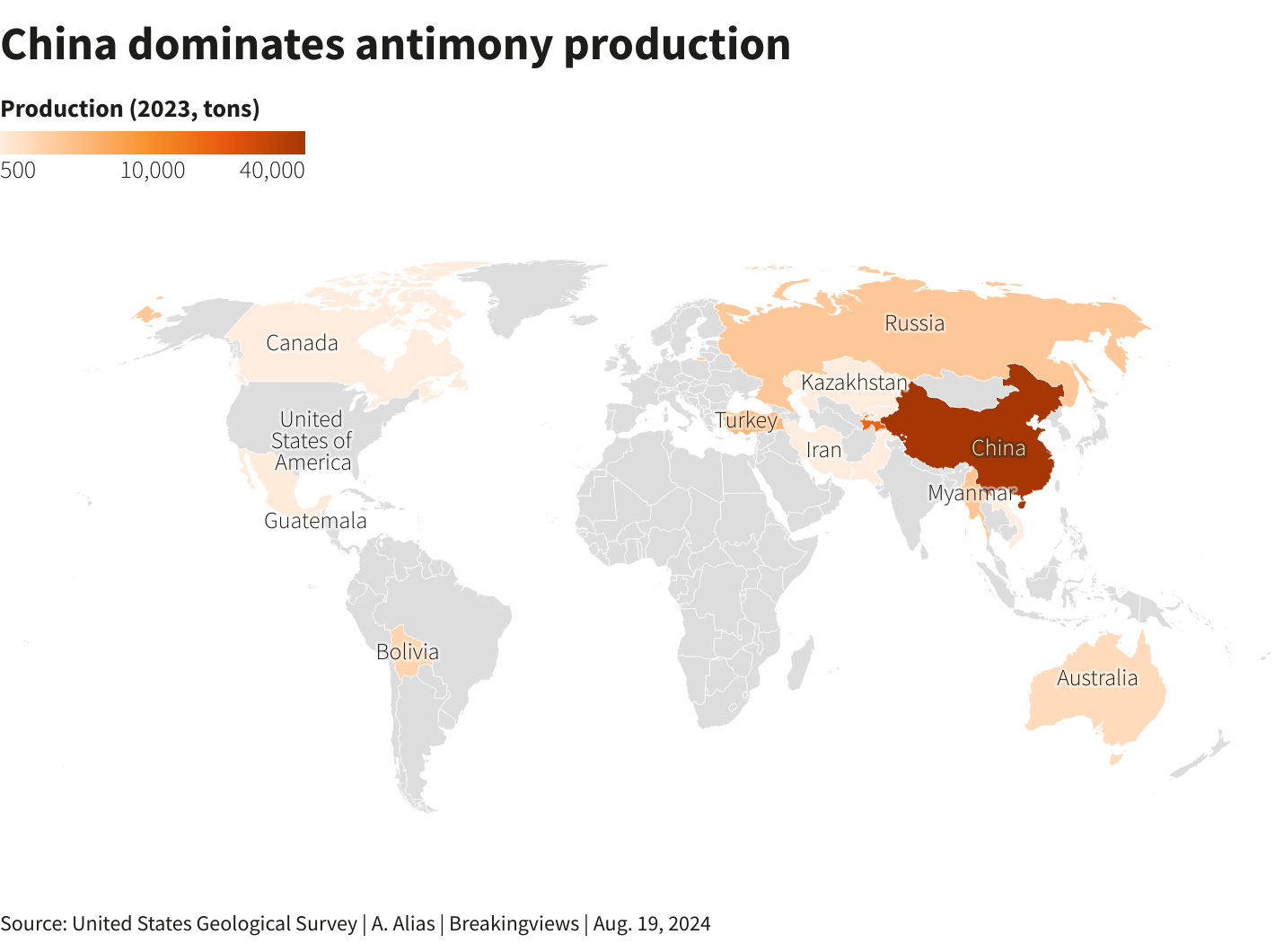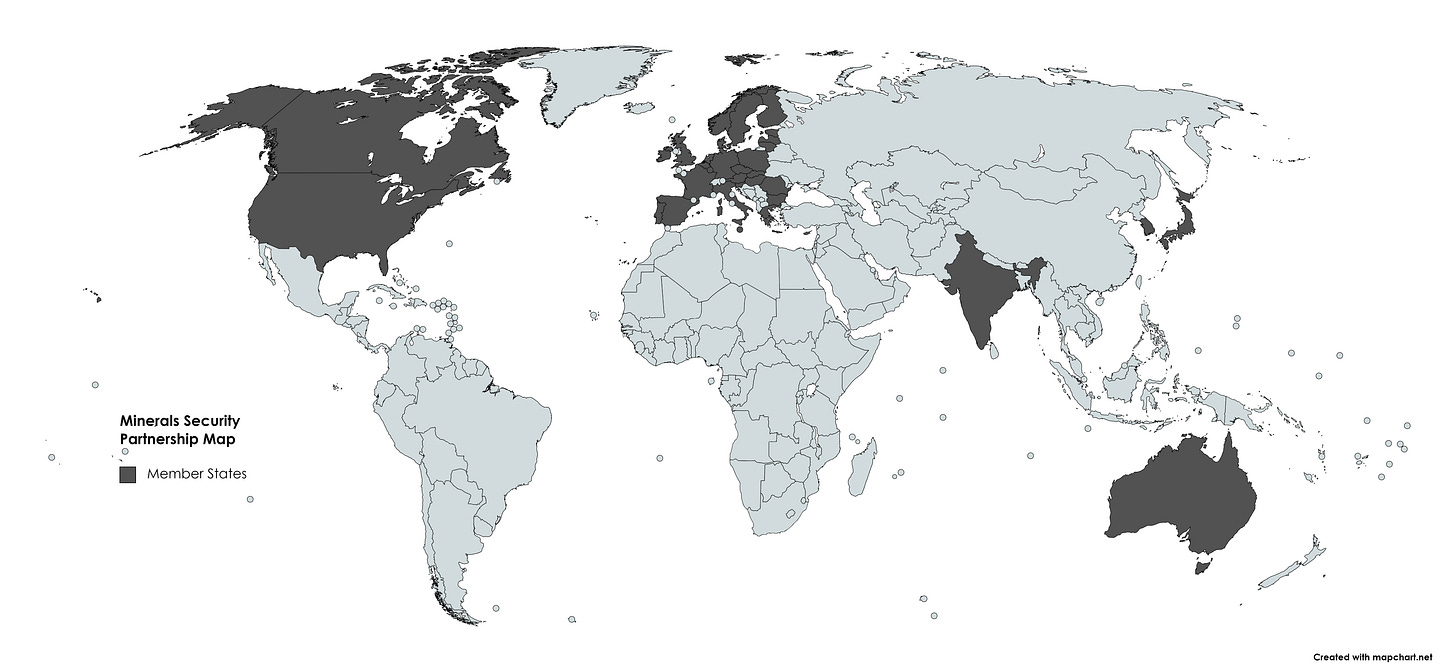Living in a material world
Intensifying geopolitical competition over critical minerals and antimony
One of the fractures in the world economy today is the intensifying geopolitical competition over the processing and obtaining of underground, shiny, and lucrative minerals. Lithium, graphite, cobalt, tungsten will be vital to the production of solar panels and electric batteries that will supposedly lead us to a green ‘transition’. They are also vital for the kind of military industrial complexes imagined for interstate wars in the 21st century. For great powers, a steady supply of critical minerals is necessary to maintain the ability to fight current and future wars and a cornerstone of geopolitical power. Where would great powers be without the ability to produce bullets, aircraft and precision missiles?
The pursuit of critical minerals looks set to be a priority for the foreseeable future. The coming US administration’s secretary of state Marco Rubio has pushed for a Global Strategy for Securing Critical Minerals (2024) to counter what he sees as China’s dominion over the critical mineral industry. In late August 2024, Italy’s prime minister Giorgia Meloni pushed for restarting mining for critical minerals in line with the European Union’s economic security strategy. Citing the acute geopolitical dependency of Europe on Russian gas (which is still being transported through Ukraine), Italy and EU countries say that they must not switch a depenedncy on Russian gas for a more ‘serious subordination to Chinese raw materials and technologies’.
China’s dominance over ‘critical minerals’ is vast. China is the world’s leading processor of 29 commodities, including 22 metals. Despite talk of an economic slowdown in China, it’s mining companies have been busy. China’s mining companies invested another USD16 billion into mining destinations overseas in 2023 up from USD 5 billion in 2020, according to data from the Economist, moving from investments around Africa, Latin America and in the MENA region.
This piece will take a closer look at China’s most recent export controls on a critical mineral called antimony and then take a look at US-led responses with the Minerals Security Partnership.
Antimony
The most recent expression of geopolitical competition in minerals came on December 3 2024. With the US expanding its sanctions of semiconductor chips, China’s Ministry of Commerce announced that exports of the metal element antimony are subject to export controls, almost one year after banning the sale of gallium, germanium and graphite. The export controls oblige companies purchasing the material to apply for a license which can be refused or accepted by the China Ministry of Commerce. This covered six antimony-related products such as antimony ore, antimony metals, antimony oxide and gold-antimony smelting and separation technologies. China justified the export controls on national security concerns and the ‘dual-use’ nature of antimony with its use in both military and civilian applications.
It turns out that is a well-founded concern. The US has listed antimony as a critical mineral due to its importance in producing armor piercing ammunition, night vision goggles, infrared sensors and precision optics for the US military. It has already been identified as a critical mineral by the outgoing Biden adminsitration as 60% of the US’ antimony supply is sourced from China. The element is also key to future technologies, with antimony used in photovoltaics, a key component in semiconductor manufacturing. About a fifth of modern antimony production is today used to make photovoltaic glass.
China can take advantage of its commanding position in the worldwide antimony market because of the development of its industry in the dirty and dangerous job of antimony refinement. According to 2021 data from the US Geological Survey, the production and refinement of antimony ore is located in Russia and China, making up 90% of total production of antimony. The key difference here is that China has invested in processing units to import cheap antimony ore deposits and refine them for export.
China’s dominance over the production of antimony has however been on the wane in the past few years due to China’s stiffening environmental regulation and depleting reserves in China’s largest mine in Hunan. In 2020, China produced 60,000 units of antimony and this decreased to 40,000 units in 2023. Nevertheless, as China’s industrial thirst for raw materials becomes greater, China’s Commerce of Ministry is also frantically searching abroad for partners willing to supply it. It now sources impurified antimony from abroad such as Myanmar, Thailand and Russia.
China’s export controls on antimony sent prices soaring for the commodity going from $14,000 at the beginning of 2024 to a height of $18,000 and counting. Given that demand for the metal is also likely to rise as military budgets and the green transition demand for batteries and solar panels increases, the price rises in the coming years will suit the suppliers just fine.
China’s export controls on antimony is not particularly significant compared with China’s dominance in other critical minerals. A lack of antimony will probably cause headaches particularly for US military suppliers ramping up production to deal with orders for the US military industrial complex. It does however demonstrate some of the surgical targeting from the Chinese government to cause inconveniences to the US military. In that regard, the US has been busy trying to source critical minerals from geopolitical chums, otherwise known as ‘friend-shoring’.
Seeking alternatives
Antimony is frequently counted as a one of the critical ‘rare earth minerals’ cited by the countries concerned about China’s dominance in the area. The concern became greater as China banned rare earth minerals to Japan in 2010 following the territorial disputes in the Senkaku/Diaoyu islands. As a response to what they see as the weaponization of China’s exports, several countries have developed a new intergovernmental institutions to build supply chain resilience and become less dependent on China.
Given that the only thing the US Congress can agree on is that China is now a geopolitical adversary and must be confronted, the Trump administration will likely continue the international assocations initiated by the Biden administration. The Minerals Security Partnership (MSP) is a US-led intergovernmental association announced by the US two years ago and met on 23 September 2024 to discuss co-operations on critical minerals. The MSP collaborates on development finance and export credit agencies with private industry and support critical mineral projects.
The MSP is an example of the changing trade regime underpinning the geopolitical competition for critical minerals. The US invited what it terms as ‘friendly’ countries which are deemed to be trusted partners against its geopoltiical adversaries. It consists of 15 countries seeking to improve investment in critical infrastructure, diversify relationships, and improve recycling of elements. This includes the US, Australia, Canada, Estonia, Finland, France, Germany, India, Italy, Japan, the RoK, Norway, Sweden, the UK and the EU Commission.
The MSP in September 2024 meeting announced the success of the 12 new projects approved since 2022 and the 32 new planned projects planned for the future with a downturn in prices for an array of metals. There is also further funding announced and new projects. These will primarily take place through the development banks from the US, such as the International Development Finance Corp. and the US Export-Import Bank.
The aim of the MSP is primarily to create new supply chains which are not reliant on China’s processing power. Yet given China’s firm advantages, the MSP still has to overcome challenges which is as much to do with their forms of political economy as well as a lack of funding. The MSP can only encourage private capital and some state-backed funders to back new mining projects. With mineral prices at low levels, there is apparently very little incentive for the Rio Tintos and Glencores of this world to invest. Compared with the combination of China’s subsidies and resulting low cost production in producing these minerals, this is a drop in the ocean. For the corporations likely to benefit, represented at the MSP were the powerful investment banks and vast mining conglomerates, including Blackrock, Goldman Sachs, Citigroup, Rio Tinto, and Anglo America to swap chairs with heads of governments.
Looking ahead
The drive for critical minerals from major powers is likely to increase in the future, with the incoming Trump administration containing an array of China hawks who insist on characterizing the competition between the US and China as an economic and technological competition. China’s export controls on antimony is likely to be the first of many export controls with this kind of tit-for-tat on critical minerals will likely increase. Whether the MSP will continue in its current form, or whether the Trump administration will burn all of its bridges remains to be seen.
While the EU and the US push to avoid excessive dependencies and taking some steps to reduce their dependence, the main danger is that the strategic search for critical minerals becomes a new form of neocolonialism. Most critical minerals are found in countries with less environemtal regulations in the Global South. As the head of the UNCTAD organization notes, the future market for the high value goods of electric cars and photovoltaics are likely to equal over $3 trillion in value by 2030 but the value of minerals vital for their production is based on current prices $300 billion. This pursuit of critical minerals threatens to reinforce vast inequalities between the cores of the world economy and through the mechanisms of extraction to the Global North at the expense of the social advancement of the Global South in the name of national security. The pursuit of geoeconomics rivalries must not be zero-sum and should advance the societies most in need.








Antimony!!!!